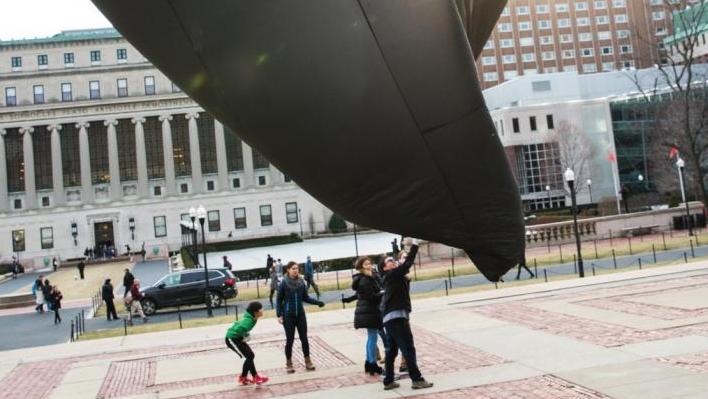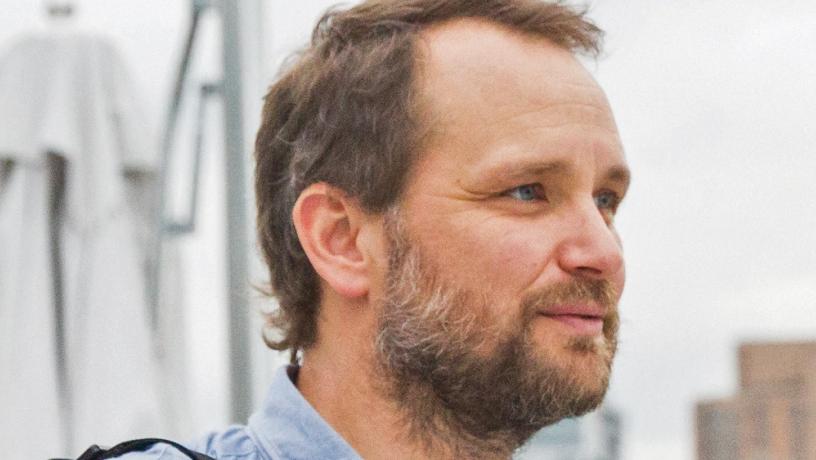Ideas Taking Flight

Students from Columbia Engineering, the Columbia Space Initiative, and the Society of Women Engineers launching an Aerocene, a type of fully aerosolar vehicle.
One breezy Saturday in late January, John Pederson ’19SEAS and Lily Zhao ’19SEAS met up with friends from the Columbia Space Initiative (CSI) and the Society of Women Engineers for a special mission. Their objective: to set aloft a giant black balloon crafted from sheets of lightweight plastic. Neither a class assignment nor a group project, the enterprise brought students together on the plaza between the South Lawn and Alma Mater to engage in a thoughtful experiment disguised as fun.
“I was on the end of the anchoring line, making sure that it wouldn’t fly away, with the cord wrapped across my shoulders like an old-time fisherman,” said Pederson, a junior studying mechanical engineering and member of CSI’s high-altitude balloons group.
Such a balloon—or the Aerocene D-O AEC, as it is officially known—is a type of fully aerosolar vehicle, engineered to lift off only by the heat of the sun and infrared radiation rising from the ground. In test flights the balloons have carried humans for hours at a time, drifting according to winds and changing atmospheric conditions. Powered by a deceptively simple concept, Aerocenes, which were officially presented at the 2015 UN Climate Change Conference in Paris, are designed to provoke big ideas about how we might reimagine transportation in a radically sustainable future.
“Sitting down to catch my breath, I looked up at the huge balloon and had a moment of awe that reminded me of the curiosity that drove me to become an engineer,” said Zhao, a fellow junior studying mechanical engineering.
Every semester, Columbia Engineering brings adventurers, engineering icons, and other thought leaders to campus. Last October, the School teamed up with the School of the Arts and the School of International and Public Affairs to add something new to the lineup: a participatory three-day residency with the multidisciplinary artist Tomás Saraceno, creator of the Aerocene and other works of art informed by the beauty of engineering.
The joint effort, a first of its kind for the three schools, consisted of a public lecture and a tour of several engineering faculty labs, as well as an artist-led workshop, which brought together engineering students with others from across the University. Saraceno bequeathed an Aerocene to the students for their own use after his visit.
“My fellow deans and I had been looking for opportunities to bring our students together in a way that allowed them to leverage their diverse talents,” said Columbia Engineering Dean Mary C. Boyce. “Tomás Saraceno’s work operates at the boundaries of so many disciplines, where a special kind of creativity flourishes. His residency is just the first of what I’m sure will be a successful run of collaborations between our schools.”
A widely recognized innovator, Saraceno weaves together art, science, and engineering in order to forge new connections and trigger new ways of understanding in a rapidly changing world—particularly pressing questions for the engineers who will build the future.
His visit represented just one instance of art enriching the labs at Columbia Engineering. Amir Baradaran is an artist-inresidence and a researcher in Professor Steve Feiner’s Computer Graphics and User Interfaces Lab. Baradaran works with both graduates and undergraduates on several augmented reality (AR) public art projects, exploring new forms of storytelling through emerging AR platforms. Working at that intersection of the two disciplines adds dimension to the educational experience, he says.
“Allowing . . . engineers to work on artistic and socially conscious projects will help them explore often unexplored sides of their lived experiences,” Baradaran said, “and hopefully prepare them to become better engineers.”
Zhao was among those who participated in the workshop, where students used the Aerocene project as a launching pad for wildly creative problem-solving. Sustainably inhabiting the skies, students speculated, provokes some of the kinds of complex questions raised by other disruptive forms of technology.
“There were so many ideas and so many amazing people across the different schools whom I might not usually get the chance to interact with,” Zhao said. “It reinforced how important it is to be more cross-disciplinary, so unique perspectives can be applied to different problems.”

As part of his three-day residency, artist Tomas Saraceno visited a number of faculty labs.
